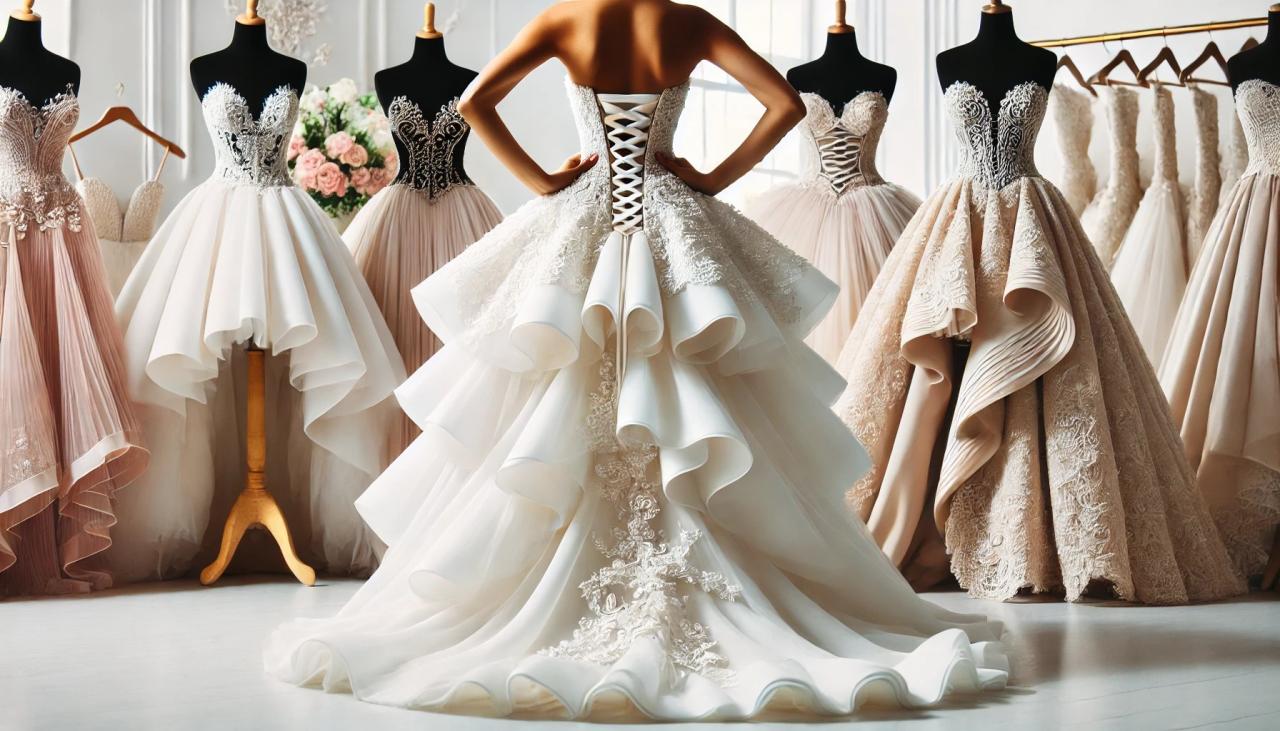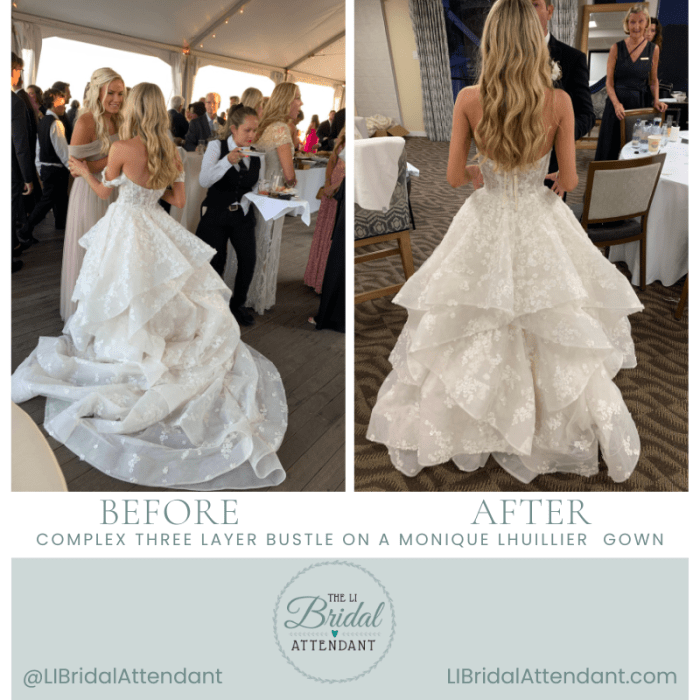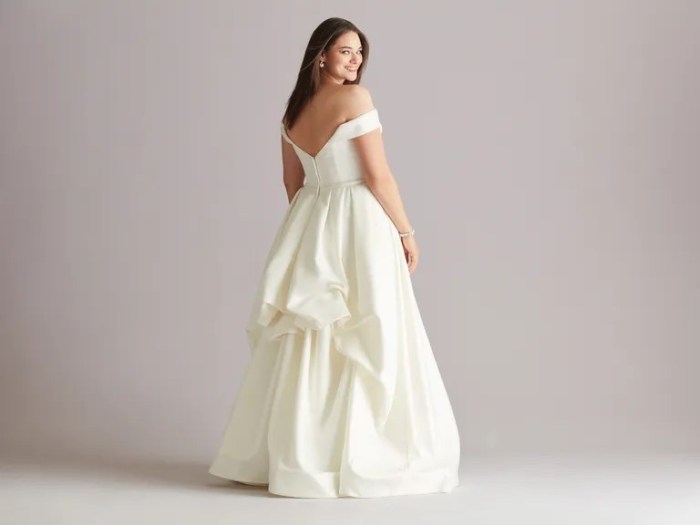Wedding Dress Train Attachments: A Comprehensive Guide
Choosing the right wedding dress train attachment is crucial for ensuring a seamless and memorable wedding day. This guide explores various attachment types, application techniques, selection factors, maintenance, and creative uses, empowering brides to make informed decisions and enjoy their special day without train-related worries.
Types of Wedding Dress Train Attachments

Source: ignitecdn.com
Several train attachment methods cater to different dress styles and preferences. Each offers unique advantages and disadvantages regarding ease of use, cost, and aesthetic appeal.
| Attachment Type | Material | Ease of Use | Cost | Suitability for Dress Styles |
|---|---|---|---|---|
| Clip-on Train | Metal clips, fabric loops | Easy; ideal for DIY | Budget-friendly | A-line, ballgown, sheath |
| Hook-and-Eye Train | Metal hooks and eyes | Moderate; requires some sewing skills or professional help | Mid-range | A-line, ballgown, mermaid |
| Bustle | Fabric tapes, ribbons, buttons | Variable; depends on bustle type and complexity | Mid-range to high-end | Most styles, particularly ballgowns and princess styles |
| Invisible Train Attachment | Hidden snaps, buttons, or loops | Difficult; requires professional alteration | High-end | All styles, especially those with intricate designs |
Attaching a Wedding Dress Train
The process of attaching a train varies depending on the chosen method. Clear instructions and practice are essential for a smooth transition between the ceremony and reception.
Attaching a Clip-on Train
A step-by-step guide for attaching a clip-on train involves aligning the clips on the train with corresponding loops sewn onto the dress’s hem, ensuring a secure and even fit. Image description: Step 1 shows the placement of the clips and loops. Step 2 depicts the secure fastening of the clips. Step 3 displays the final, neatly attached train.
Using a Bustle to Attach a Train
Different bustle styles (e.g., French, over-bustle, etc.) require varying techniques. A French bustle, for instance, involves carefully looping and securing the train using fabric tapes and buttons to create a structured, raised effect. Image description: Step 1 shows the placement of tapes. Step 2 illustrates the looping of the train. Step 3 shows the finished French bustle.
An over-bustle involves creating a more dramatic uplift of the train using additional fabric or a separate structure. Image description: Step 1 shows the over-bustle structure. Step 2 illustrates the attachment process. Step 3 shows the finished over-bustle.
Tips for secure attachment include using additional safety pins or ensuring the chosen method suits the dress weight and fabric.
Removing a train involves carefully unfastening the clips, hooks, or bustle components, gently lowering the train to avoid damage.
Choosing the Right Train Attachment
Several factors influence the choice of train attachment. A detailed consideration ensures the chosen method complements the dress, venue, and wedding activities.
- Train length and weight
- Dress fabric
- Wedding venue (indoors vs. outdoors)
- Wedding activities (dancing, outdoor photos)
- Personal preferences
An unsuitable attachment can lead to snagging, tearing, or an uneven look. Solutions include choosing a more robust attachment, adding reinforcement to the dress, or seeking professional help.
Maintaining and Caring for Train Attachments

Source: squarespace-cdn.com
Proper care ensures the longevity of train attachments and prevents damage. Regular cleaning, careful storage, and prompt repair are crucial.
- Cleaning instructions vary depending on the material. Delicate fabrics may require professional cleaning.
- Storage should be in a cool, dry place, ideally in a garment bag or protective box.
- Minor damages, like loose threads, can be repaired with needle and thread.
- Prevention includes avoiding dragging the train excessively and inspecting it regularly for wear and tear.
Creative Uses of Train Attachments

Source: theknot.com
Train attachments offer opportunities for diverse looks throughout the wedding day, enhancing photography and personal style.
- Different bustle styles can create various silhouettes for the reception.
- Posing with the train can create dramatic and romantic photographs.
- Unique uses might include incorporating the train into a special dance or a unique wedding ceremony element.
Image description 1: A ballgown with a French bustle, showcasing a classic and elegant look. Image description 2: A mermaid gown with a clip-on train, highlighting a sleek and modern silhouette. Image description 3: An A-line dress with a dramatic over-bustle, creating a voluminous and romantic effect.
Top FAQs: Wedding Dress Train Attachment
Can I attach a train to any wedding dress?
Most wedding dresses can accommodate a train attachment, but dresses with intricate detailing or delicate fabrics might require specialized attachments or professional assistance.
How much does a wedding dress train attachment cost?
Wedding dress train attachments offer a fantastic way to add drama and elegance to a shorter gown, providing the sweeping look you desire without sacrificing ease of movement. The choice of attachment often depends on the overall style, and this is particularly true when considering the hairstyle; for instance, a more elaborate train might complement a sleek, sophisticated look, as seen with many styles featured on sites discussing wedding dress short hair.
Ultimately, the train attachment should enhance the entire bridal ensemble, creating a cohesive and stunning effect. Therefore, careful consideration of the overall design is key when selecting the perfect train attachment.
Prices vary greatly depending on the type of attachment (e.g., simple clip-on vs. elaborate bustle) and the materials used. Expect to pay anywhere from a few dollars to several hundred.
Can I attach the train myself, or do I need professional help?
Simple clip-on attachments are generally easy to manage independently. More complex bustles often benefit from professional assistance to ensure a secure and aesthetically pleasing result.
What if my train attachment breaks during the wedding?
Having a small sewing kit on hand can help with minor repairs. Consider bringing a safety pin or some strong thread for emergencies. For significant damage, seek professional help.
